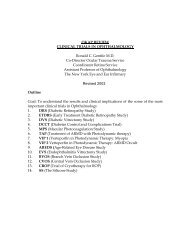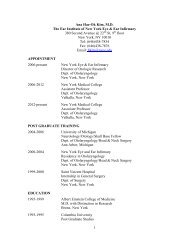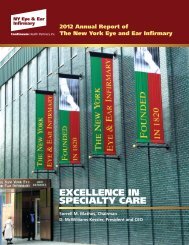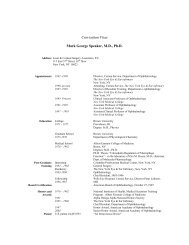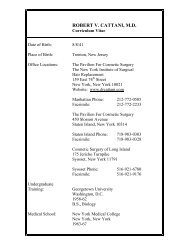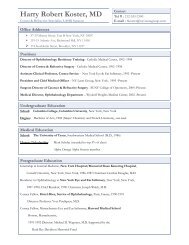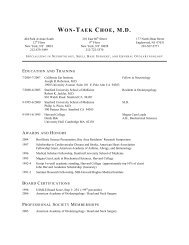BOARD And OKAP REVIEW COURSE Diagnosis â Management Of
BOARD And OKAP REVIEW COURSE Diagnosis â Management Of
BOARD And OKAP REVIEW COURSE Diagnosis â Management Of
You also want an ePaper? Increase the reach of your titles
YUMPU automatically turns print PDFs into web optimized ePapers that Google loves.
<strong>BOARD</strong> and <strong>OKAP</strong> <strong>REVIEW</strong> <strong>COURSE</strong><br />
<strong>Diagnosis</strong> - <strong>Management</strong> of Anterior Uveitis Syndrome<br />
Lawrence V. Najarian, M.D.<br />
Revised 2004
<strong>Diagnosis</strong> – <strong>Management</strong> of Anterior Uveitis Syndrome<br />
Classification of Uveitis<br />
• Oldest clinical classification scheme involves the differenciation between granulomatous<br />
and non-granulomatous uveitis.<br />
General<br />
Anterior Segment<br />
Posterior segment<br />
Intraocular Inflammation<br />
More frequently involved<br />
anterior and Posteriour uveal<br />
areas. Insidious onset,<br />
chronic course<br />
Insidious onset, mild, eye<br />
nearly white. Nodules,<br />
Floccules on iris. Medium<br />
and large (often “mutton-fat”)<br />
Keratic precipitates. Slight<br />
flare.<br />
Common in choroids retina.<br />
Heavy vitreous exudates.<br />
Anterior Uvea most frequently<br />
involved. Acute onset, short<br />
course.<br />
Acute onset, Red eye, no nodules<br />
or floccules on iris; heavy<br />
fibrinous exudates, intense flare.<br />
Rare Choroidal, retinal lesions.<br />
Fine vitreous opacities.<br />
Examples of granulomatous uveitis etiologies: TB, syphilis, sarcoid, brucellosis, toxoplasmosis.<br />
Endogenous vs. infectious<br />
Anatomic Classification: International Uveitis Study Group, 1989<br />
Anterior uveitis<br />
Intermidiate uveitis<br />
Posterior uveitis<br />
Pan uveitis<br />
Guidelines for the IUSG recommended classification of Uveitis<br />
Onset and duration of disease<br />
“Acute” 2-6 weeks<br />
“Short” Under 3 months<br />
“Chronic” Greater than 3 months<br />
Unilateral or bilateral<br />
Demographics (age, sex, race)<br />
Response to therapy<br />
Is the disease steroid-responsive, or dependent or resistant?<br />
Anatomic position<br />
Pattern, i.e., single vs. recurrent episodes<br />
Granulomatous vs. non-granulomatous<br />
Severity of visual loss: sever vs. mild<br />
Severe = visual loss of 50% or more compared to predisease state<br />
General Medical History<br />
Pediatric Anterrior Uveitis
Uveitis in children under age 16 uncommon.<br />
Comprise only 5-6% of all uveitis cases.<br />
Etiology found in about 50% of all anterior and posterior cases<br />
Presentation<br />
Acute: Photophobia, decreased vision, pain, redness<br />
Insidious: Increased lacrimation, decreased vision found on routine vision screening<br />
(JRA).<br />
Differential diagnosis:<br />
Trauma/child abuse<br />
Sympathetic ophthalmia<br />
Juvenile Rheumatoid Arthritis (see below)<br />
Leading cause, by far, of anterior uveitis.<br />
Risk Factors for uveitis include both pauciarticular disease & ANA positivity.<br />
Sarcoid: Characteristic triad. No lung involvement<br />
Granulomatous uveitit<br />
Arthritis – non tender effusion of knees and wrists<br />
Rash<br />
Non specific – erythema nodosum<br />
Specific – non caseating granulomas<br />
Herpes Simplex – may be associated with hyphema, glaucoma & iris atrophy<br />
Herpes Zoster – Usually develops during convalescence from a varicella infection<br />
Syphilis:<br />
Hutchinsons’ Triad: 8 th Never deafness, interstitial keratitis, widely spaced &<br />
notched teeth<br />
Salt and peper fundus<br />
Saber shins<br />
Saddle nose deromity<br />
Kawasaki Disease: Mucocutaneous Lymph Node Syndrome<br />
Characterized by 5-day fever, rash, lympadenopathy, conjunctivitous, mucous<br />
membrane involvement, in most Oriental children.<br />
Acute, bilateral, non-granulomatous inflammation in 80% of patients, self limited.<br />
Anterior Uveitis Syndorme<br />
Rheumatoid Arthritis<br />
Adult Rheumatoid Arthritis:<br />
NOT associated with increased risk of anterior uveitis<br />
Sjorgren’s Syndrome<br />
Scleritis<br />
Sclerokeratitis<br />
Juvenile Rheumatoid Arthritis (JRA)<br />
Leading cause of pediatric uveitis<br />
Leading cause of chronic crippling disease of children<br />
Predictive indicators for increased risk of uveitis include:<br />
Pauciarticular (less than 4-joint involvement) JRA<br />
Seronegativity for rheumatoid factor<br />
ANA positivity: 80% of patients with a positive ANA & JRA
ALL ANA positive, pauciarticular JRA patients should be routinely<br />
screened by an ophthalmologist every 3 months<br />
Three (3) major forms of JRA<br />
Pauciarticular disease – 40% with ANA<br />
Polyarticular disease – 40%<br />
Systemic Disease – 20%<br />
Pauciarticular JRA – 2 types<br />
Type I<br />
Onset: early childhood<br />
25% of all JRA<br />
Girls:boys – 7:1<br />
ANA Positive in 50% of pts<br />
RF negative<br />
Major complications is<br />
iridocyclitis<br />
Type II<br />
Onset: late childhood<br />
15-20% of all JRA<br />
Girls:boys – 1:10<br />
ANA negative<br />
RF negative<br />
Hip and sacroiliace<br />
involvement common<br />
Ocular Symptoms<br />
Insidious – 56% of children<br />
Photophobia<br />
Epiphora<br />
Injection<br />
Mild pain<br />
Seronegative Spondylarthritis: Eye involvement – non granulomatours uveitis.<br />
Conditions leading to Sacroiliitis<br />
*Ulcerative Colitis<br />
*Reiters Syndrome<br />
*Ankylosing spondylitis<br />
*Crohn’s Disease<br />
*Psoriasis<br />
*High association with LFA-B27 and uveitis<br />
Frequency of HLA-B27 in general population: 1.4-6%<br />
Frequency of HLA-B27 in patients with acute uveitis: 50-60%<br />
Excluding<br />
Inflammatory Bowel Disease:<br />
Frequency of uveitis greater in those patients with sacroillitis and HLA-B27 positivity.<br />
Terms Ulcerative Colitis & Crohn’s Disease frequently confused in literature<br />
Uveitis rare with ulcerative colitis but see it in 20% of patients with Crohn’s Disease.<br />
For board purposes uveitis occurs with each disease.<br />
Ankylosing Spondylitis = Murie-Strumpell Disease<br />
Symptoms: lower back pain & stiffness after inactivity.<br />
May be infectious; triggers Klebsiella.<br />
Frequency of HLA-B27 approaches 90%<br />
Order Sacroiliac x-rays, NOT lumbosacral films<br />
50% of patients asymptomatic but x-rays positive<br />
5% of patients develop aoritis.
Rieter’s Syndrome: frequently diagnosed retrospectively.<br />
Triad of urethritis, conjunctivitis and non gonoccocol polyarthritis.<br />
May occur after dysentery without urethritis.<br />
Possible triggers: chlamydia, shigella, salmonella & Yersinia<br />
Occurs primarily in males and is bilateral<br />
80% association with HLA-B27<br />
Psoriatic Arthritis<br />
The Uveitis is usually seen in those patients who also have arthritis.<br />
Behcet’s Syndrome – Type 3 Immune Response<br />
Classic triad: acute hypopyon uveitis, aphthous, stomatitis, and genital<br />
ulcerations.<br />
Common Japan, Near East, Mediterranean<br />
Blindness results from retinal vasculitis.<br />
25% of Patients develop stroke<br />
Associated with HLA-B5 (subtype of MGA B-51)<br />
Connective tissue disorders and eye involvement:<br />
Systemic Lupus Erythematosis: Type 3 Immune Response<br />
Retinal findings: Vasculitis, hemorrhage, cotton-wool spots.<br />
More Uveitis Syndromes:<br />
Fuchs’ Heterochromic Iridocyclitis<br />
Diffuse iris stromal atrophy with variable pigment layer causing heterchromia<br />
Small, white keratic precipitaes equally distributed over entire endothelium<br />
Minimal aqueous cells and flare<br />
Synechiae almost never form<br />
Usually unilateral<br />
Glaucoma and cataract common<br />
Minimal symptoms<br />
Glaucomatocyclitic crisis – Posner-Schlossman Syndrome<br />
Unilateral, mile, acute iritis<br />
Markedly increased intraocular pressure<br />
Recurrences common<br />
Granulomatous Uveitis:<br />
Sarcoid – Type 4 Immune Response<br />
Ocular inflammatory disease seen in 25-50% of patients with systemic sarcoid<br />
More common in African Americans, Scandinavians<br />
Multi-system disease primarily affectin pulmonary function.<br />
CNS, Liver and cutaneous involvement common<br />
Ocular involvement:<br />
Orbital disease: lacrimal gland, etc.<br />
Anterior segment: “mutton-fat” keratic precipitates<br />
Posteriou segment: vitreous “snowballs”,”candle wax drippings”<br />
(Periplebitis)<br />
Pathology:<br />
Noncaseating granuloma: conjunctival biopsy<br />
Schaumann’s or lamellar bodies, asteroid bodies<br />
Anergy: 90% of patients
or<br />
Testinglimited gallium scan of head/neck<br />
serum lysozyme<br />
biopsy<br />
Tuberculosis – once very common<br />
<strong>Diagnosis</strong>: high index of suspicion<br />
Treatment: INH, Rifampin, Pyridoxine<br />
Syphilis - :The Great Imitator”<br />
May simulate all pattens of anterior and posterior uveitis<br />
May be VDRL negative, FTS-ABS positive<br />
High degree of suspicion in sexually active population<br />
Up to 70% of males with acquired syphilis are homosexual<br />
Treatment:<br />
Benzathine penicillin, IM, weekly x3<br />
Aqueous procaine penicillin IM with probenecid<br />
Intravenous penicillin C.<br />
Lens induced uveitis – Type 3 Immune Response<br />
Phacoanaphylactic endohthalmitis (phacoantigenic uveitis)<br />
Immune response to lens protein release seen after injury to lens capsule<br />
ECCE.<br />
Autologous lens protein may become autoantigenic after exposure<br />
to aqueous humor<br />
A zonal granulomatous inflammation<br />
Macrophages with lens material<br />
Associated with sympathetic ophthalmia in 25% of cases<br />
Treatment: steroids, cycloplegia, removal of lens material<br />
Vogt-Koyanagi-Harada Syndrome<br />
Seen in pigmented individuals with Indian heritage<br />
Vitiligo, alopecia, poliosis, dysausia, meringismas<br />
Exudative retinal detachment with vitreous cells<br />
“Sunset fundus” characteristic of past inflammation.<br />
Treatment of Anterior Uveitis<br />
Goal of therapy is to suppress inflammation and thereby minimize its destrictive<br />
sequelae.<br />
Specific treatment of causative condition<br />
Example – treat syphilitic uveitis with penicillin.<br />
Non-specific treatment: Immunosuppressives and Cycloplegics<br />
Steroids: mode of administration and complications:<br />
Topical:<br />
Glaucoma<br />
Posterior subcapsular opacities<br />
Opportunistic corneal infections<br />
Transient mydriasis and ptosis<br />
Periocular:
Growth retardation<br />
Centera vasculature emboli<br />
Subconjunctival collection<br />
Systemic:<br />
Peptic ulcer<br />
Osteoporosis<br />
Increased severity of diabetes and hypertension<br />
Mental changes<br />
Electrolyte imbalance<br />
Reactivation of infection (TB)<br />
Asceptic necrosis of femoral + humoral head<br />
Cycloplegia – Goals of treatment<br />
Stop Pain of ciliary spasm induced by acute irititis<br />
Prevent posterior synechiae and resultant risk of papillary block glaucoma<br />
Complications of Uveitis: secondary to disease process vs. medical treatemtn:<br />
Band keratopathy (JRA)<br />
Corneal edema<br />
Cataracts<br />
Glaucoma<br />
Synechia formation: anterior and posterior<br />
Hypotony<br />
Retinal edeman and detachment<br />
Optic neuritis<br />
Neovascularization<br />
Myopia from ciliary spasm<br />
Hyperopia from macula edema<br />
Macular edema is the most common finding seen in posterior & intermediate<br />
uveitis.<br />
Macular edema in the most common cause of decreased vision associated with<br />
chronic inflammations.<br />
Masquerade Syndromes – Anterior uveitis<br />
Retinoblastoma<br />
Leukemia<br />
Intraocular foreign body<br />
Malignant melanoma<br />
Juvenile xanthogranuloma can present with inflamed retina<br />
Retinal detachment<br />
Spillover syndromes: all causes of posterior uveitis<br />
Ocular ischemia






